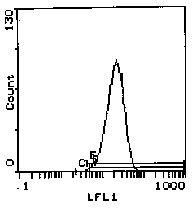Itga4 Rat Monoclonal Antibody [Clone ID: R1-2]
Specifications
| Product Data | |
| Clone Name | R1-2 |
| Applications | FC, IHC, IP |
| Recommended Dilution | Flow cytometry (see protocol/specificity). Immunoprecipitation. Immunohistochemistry. (1,2,3). |
| Reactivities | Mouse |
| Host | Rat |
| Isotype | IgG2b |
| Clonality | Monoclonal |
| Immunogen | Peyers Patch HEV binding lymphoma line (TK1) |
| Specificity | CL030 reacts with a4 integrin, which helps to mediate cell-cell and cell-matrix interactions. Tissue Distribution by Flow Cytometry Analysis (see protocols below): Rat Strain: BALB/c Cell Concentration : 1x10e6 cells per tests Antibody Concentration Used: 1:1000 in 50µl/10 cells Isotypic Control: Rat IgG2b Cell Source Percentage of cells stained above control (see protocols below): TK1 cells 99.3% Spleen 89.1% Thymus 92.1% Bone Marrow 67.4% Strain Distribution by Flow Cytometry Analysis (see protocols below): Tissue: Spleen Cell Concentration : 1x10e6 cells per tests Antibody Concentration Used: 1:500 in 50µl Strains Tested: BALB/c, C57BL/6, C3H/He, CBA/J, AKR Positive: BALB/c, C57BL/6, C3H/He, CBA/J, AKR Negative: none |
| Formulation | State: Ascites State: Lyophilized ascitic fluid |
| Reconstitution Method | Restore with 0.5 ml of cold distilled water. |
| Database Link | |
| Background | alpha4 integrin combines with beta1 and beta7integrin to form VLA-4 and LPAM-1 (Peyers patch homing receptor) respectively. VLA-4 is expressed on most peripheral lymphocytes, thymocytes and monocytes. LPAM-1 is found on peripheral lymphocytes, but few thymocytes. Fibronectin and VCAM-1 act as ligands for both VLA-4 and LPAM-1. LPAM-1 also binds the mucosal vascular addressin MAdCAM-1. (1) |
| Synonyms | Integrin alpha-4, Integrin alpha-IV, VLA-4, VLA4 |
| Note | Appropriate control samples should always be included in any labelling studies. Protocol: FLOW CYTOMETRY ANALYSIS: Method: 1. Prepare a cell suspension in media A. For cell preparations, deplete the red blood cell population. 2. Wash 2 times. 3. Resuspend the cells to a concentration of 2x10e7 cells/ml in media A. Add 50 µl of this suspension to each tube (each tube will then contain 1x10e6 cells, representing 1 test). 4. To each tube, add 50ml of a 1:500-1000 dilution of antibody. 5. Vortex the tubes to ensure thorough mixing of antibody and cells. 6. Incubate the tubes for 30 minutes at 4°C. 7. Wash 2 times at 4°C. 8. Add 100 µl of secondary antibody (FITC Goat anti-rat IgG (H+L)) at a 1/500 dilution. 9. Incubate the tubes at 4°C for 30-60 minutes. (It is recommended that the tubes are protected from light since most fluorochromes are light sensitive). 10. Wash 2 times at 4°C in media B. 11. Resuspend the cell pellet in 50 µl ice cold media B. 12. Transfer to suitable tubes for flow cytometric analysis containing 15 µl of propidium iodide at 0.5 mg/ml in PBS. This stains dead cells by intercalating in DNA. Media: A. Phosphate buffered saline (pH 7.2) + 5% normal serum of host species + sodium azide (100 µl of 2M sodium azide in 100 mls). B. Phosphate buffered saline (pH 7.2) + 0.5% Bovine serum albumin + sodium azide (100 µl of 2M sodium azide in 100 mls). |
| Reference Data | |
Documents
| Product Manuals |
| FAQs |
| SDS |
{0} Product Review(s)
0 Product Review(s)
Submit review
Be the first one to submit a review
Product Citations
*Delivery time may vary from web posted schedule. Occasional delays may occur due to unforeseen
complexities in the preparation of your product. International customers may expect an additional 1-2 weeks
in shipping.






























































































































































































































































 Germany
Germany
 Japan
Japan
 United Kingdom
United Kingdom
 China
China



